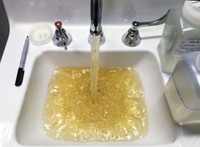Advertisement
Grab your lab coat. Let's get started
Welcome!
Welcome!
Create an account below to get 6 C&EN articles per month, receive newsletters and more - all free.
It seems this is your first time logging in online. Please enter the following information to continue.
As an ACS member you automatically get access to this site. All we need is few more details to create your reading experience.
Not you? Sign in with a different account.
Not you? Sign in with a different account.
ERROR 1
ERROR 1
ERROR 2
ERROR 2
ERROR 2
ERROR 2
ERROR 2
Password and Confirm password must match.
If you have an ACS member number, please enter it here so we can link this account to your membership. (optional)
ERROR 2
ACS values your privacy. By submitting your information, you are gaining access to C&EN and subscribing to our weekly newsletter. We use the information you provide to make your reading experience better, and we will never sell your data to third party members.
Water
Legionnaires’ outbreaks in Flint linked to corrosive tap water
Corrosion in drinking water pipes allows deadly bacteria to flourish
by Janet Pelley
July 25, 2016


The water crisis in Flint, Mich., didn’t just poison children with lead; it also likely contributed to two outbreaks of Legionnaires’ disease, according to a new study (Environ. Sci. Technol. Lett. 2016, DOI: 10.1021/acs.estlett.6b00192).
In 2014, Flint stopped taking drinking water from Detroit and instead started treating water from the nearby Flint River. After this switch, the city’s treatment plant didn’t adequately control the water’s corrosiveness, creating ideal growth conditions for deadly Legionella bacteria. The study is a wake-up call to the many cities failing to address corrosion in their aging water pipes, the authors say.
Legionnaires’ disease is a deadly pneumonia caused by inhaling Legionella bacteria that lurk in the organic matter lining drinking water pipes. “Lab-scale type studies have illustrated that corrosion in drinking water pipes can stimulate the growth of Legionella,” says Amy Pruden, an environmental microbiologist at Virginia Tech and an author of the study. Corrosive water dissolves the protective mineral lining in pipes and then leaches iron out of old iron pipes. Iron is a micronutrient that boosts Legionella reproduction. The metal also reacts with and inactivates chlorine disinfectant that otherwise would kill the bacteria.
The Virginia Tech team thought conditions in Flint were ripe for Legionella. So before the city switched back to Detroit water in October 2015, the scientists sampled Flint’s water for Legionella, iron, and free chlorine. At the time of sampling, Flint had already experienced outbreaks of Legionnaires’ disease in June 2014 and May 2015.
The researchers, led by Marc A. Edwards, collected tap water samples from homes and hospitals in and around Flint and determined Legionella concentrations using quantitative polymerase chain reaction methods. They compared the measurements to those from baseline U.S. water surveys that they and the Environmental Protection Agency carried out in the absence of outbreaks and to those from Flint buildings that remained on Detroit water.
In homes supplied with Flint River water, the scientists recorded Legionella concentrations roughly seven times as high as those found in the baseline surveys. The team found high levels of iron, 51 ppb, in the Flint homes and hospitals using Flint River water, but found no iron in nearby businesses using Detroit water. In more than half the water samples from homes supplied with the treated Flint River water, the researchers could not detect any chlorine. No Legionella bacteria were detected in the buildings using Detroit water.
“All this information adds up: The conditions that resulted from the switch in source water were favorable to growth of Legionella, and because of that, disease cases occurred after the switch,” says Janet E. Stout, director of the Special Pathogens Laboratory in Pittsburgh, the nation’s leading Legionella testing lab. “Water operators need to understand that when water service is disrupted, the risk of Legionnaires’ disease can go up and the community should be notified,” she concludes.
Legionnaires’ disease 101
Cause: Breathing in small droplets of water containing Legionella bacteria
Incidence: 5,000 cases per year in the U.S.
Fatality frequency: One in 10 cases
Who’s vulnerable? People over 50, smokers, people with chronic lung disease, and people with compromised immune systems
Symptoms: Cough, shortness of breath, fever, muscle aches, headaches, and more
Source: Centers for Disease Control & Prevention





Join the conversation
Contact the reporter
Submit a Letter to the Editor for publication
Engage with us on Twitter